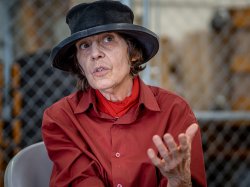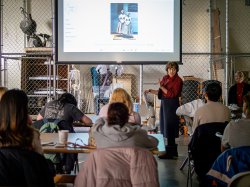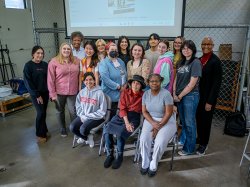Gabriel Koren
Activist Sculptor Gabriel Koren Inspires Aspiring Art Teachers
Posted in: College News and Announcements

Aspiring art educators at Montclair State University found inspiration from sculptor Gabriel Koren, who recently visited campus to share how her artistic journey from her native Hungary to New York City led to her work of prominent African Americans.
Koren was the guest of the Montclair’s Center of Pedagogy, which invited the artist to speak to Art Education students in the University’s art studios. In providing a lens for looking at art as a platform for social justice, the future teachers learned how including the arts in the study of black history can make a difference in the lives of their future elementary and secondary school students.

In her talk, Koren shared how she emigrated 46 years ago to New York from Budapest, Hungary, to experience cultural diversity in all of its many forms. She quickly learned, however, that understanding culture is more than mere immersion and she also learned how segregated the United States really is.
After many attempts to develop cross-cultural friendships, Koren decided she felt a connection to the Civil Rights activists she had listened to and seen at lectures. A new passion to learn about the African American experience grew, according to her artist’s statement. “For 15 years I attended history lectures in African American churches and community centers,” she says. “I learned from the most respected history professors in the community, teaching African American history.”

These lectures were the source of her inspiration to create sculptures of great African American historical figures.
When the city of New York decided to re-vision and remake the northwest corner of Central Park into something more than a turn-around, they considered the history of Harlem and the African American experience in America. Koren won the Central Park Conservancy design competition. She created the eight-foot bronze portrait sculpture of Frederick Douglas that now anchors the crossroads of Central Park West and 110th Street-Frederick Douglass Boulevard.
Douglass was committed to women’s rights and endorsed women’s suffrage and Koren included granite blocks that form seating encircling the bronze sculpture of Douglass. On one of the granite blocks one can read Douglass’ words: “Whatever may be said as to a division of duties and avocations, /The rights of man and the rights of woman are one and/inseparable, and stand upon the same indestructible basis. 1851”
“Creating space for justice, equity and fairness might seem like a lofty and unreachable goal,” says Art and Design Assistant Professor Dorothy Heard, who hosted the sculptor in our Calcia studio. “Except when we remember Frederick Douglass who lived a life that showed us that we all individually and collectively, have the capacity to rethink and recreate our relationships and our spaces. We can rethink and remake our ideas about race and gender.”
Koren follows in the path of other women artists who depicted the lives of ordinary people and paths of possibility extraordinary people create, Heard explains. Anne Whitney (1821-1915) was a successful American woman artist who made portrait-sculptures of abolitionists and suffragists. African American woman artist Edmonia Lewis (1844-1907) carved a medallion depicting abolitionist John Brown. Best known for her sculpture of a young black boy in ordinary clothing, the 1930s African American woman artist Augusta Savage (1892-1962) opened a community art center in Harlem.

Like these women artists who came before her, Koren is keenly aware of the community, place, space and history.
Koren’s life-sized sculpture of Malcolm X is on display in the Malcolm X and Betty Shabazz Educational and Resource Center, in the very location where El-Hajj Malik Shabazz, Malcolm X, was assassinated in Harlem.
Her lesser known piece, Prudence Crandall and Student, is most revealing of Koren’s desire to use art to tell profound stories about people who made a difference. A Quaker abolitionist activist teacher, Crandall withstood white supremacist backlash when she opened the first school in 1833 for African American girls in Canterbury, Conn. Koren refused to complete the project commissioned by the state of Connecticut until the entire story was told. According to Koren, the statue would be incomplete without a statue of her student standing nearby.
“Find your passion,” Koren told the future art teachers. “Then pursue it with all of your determination. Then you will find success and fulfillment in life.”

Photos by University Photographer Mike Peters.
